Yeah, “The Best Way to Make Cold Brew Coffee is Also the Easiest Way to Deal with the Grounds – Also: the Best Ratio for that Cold Brewed Coffee!” is a long title, but I needed to let you know what you’re in for. So hang on, because I’m going to rock your cold brew world! (Update: Ok, I just changed it to “The Best Way to Make Cold Brew Coffee Plus No-Mess Coffee Grounds! Also: the Best Ratio for that Cold Brewed Coffee!”..slightly better.)
Before we go any further, let’s clear up something at the outset: when you brew cold brew coffee you are making a coffee concentrate, which, in order to drink, you will first dilute with water (unless you’re looking for a crazed-weasel level of caffeine). That is one of the two perfect ratios people want to know – how much coffee concentrate to how much water. More on that below.
We got on the cold brew kick because – let’s face it – we’re lazy (which made dealing with cold brew grounds..heck, any grounds, a hassle, which makes our discovery even all the more exciting, but more on that in a moment).
The fact that it makes a cup of coffee so smooth that even if you slathered a baby’s bottom with the smoothest of mashed avocado, and topped it off with whipped cream, it couldn’t compete, is just an added benefit.
And the fact that cold brew allows you to tweak the strength of your coffee to just how you like it – from ‘delicate with a hint of coffee aroma’ to ‘motherfather can we dial it down to just high octane’? Another added benefit.
Have I mentioned that we’re lazy? And that we don’t like to deal with the grounds?
This is the lazyperson’s cold brew method, and the fact that it just happens to make amazing, smooth coffee is a bonus. Or, if you aren’t so lazy, then the fact that this cold brew method, that makes amazingly smooth coffee, is also super easy to make and super easy when it comes to dealing with the grounds is the bonus.
Either way, I’m sure you’ll agree that it’s PDA (that’s Pretty Damn Awesome, not public display of affection, although those are PDA too (see what I did there?)).
First we tried making it with our French press. It worked ok, but part of the whole laziness thing is that dealing with those grounds is a hassle.
So then, thinking it would be less hassle (and hey, more coffee!) we got one of these:
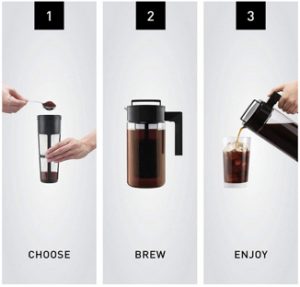
(That’s the “Takeya Deluxe Cold Brew Iced Coffee Maker with Airtight Lid”, which not only was even more of a hassle, but apparently that “airtight lid” isn’t water-tight – it leaked (only slightly, but still).
One day I was cleaning out the cupboard, and came across something that we had used months before in our futile efforts to make dealing with spent coffee grounds easier. They were filters for our French press (yes, we’re that lazy). My other half didn’t love them (hot coffee grounds and all that), so we used one, and then put the other 99 in the cupboard and promptly forgot about them.
Until I was cleaning out the cupboard and saw them, and pulled them out, and was just about to post them on Nextdoor in case someone else with a French press wanted to try them – seriously, I had already written the post and was proofreading it before pressing ‘send’ when…
LIGHTBULB!!
“Hey, these look like they would just fit in a Mason canning jar!”
(Yeah, we have talking light bulbs at our house.)
And thus the Best Way to Make Cold Brew Coffee Plus No-Mess Grounds (BWMCBCPNMG) was born! And here it is.
The Best Way to Make Cold Brew Coffee Plus No-Mess Coffee Grounds! Also: the Best Ratio for that Cold Brewed Coffee!
For this method you will need:
- Mason (or other) 1 quart canning jars – as many as you want to store in your fridge at once
- French press coffee filters (see link below)
- Coffee (obviously) – course ground, as for a French press, is best
Instructions
Open and insert one French press coffee filter into each empty Mason jar, folding the top down over the outside of the jar.
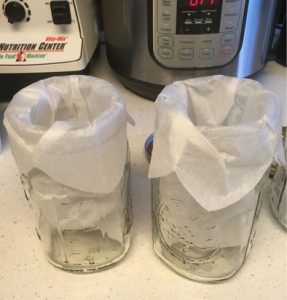
Measure 2/3 cup coffee grounds (there’s that magic ratio) into each filter. So that ratio is 2/3 cup grounds to nearly 1 quart of water (nearly because even though you will fill the jars with water, some of the volume is taken up by the coffee).
Note that we use a canning funnel to do this, which makes it so much easier. You can get a canning funnel at most hardware stores, or on Amazon here.
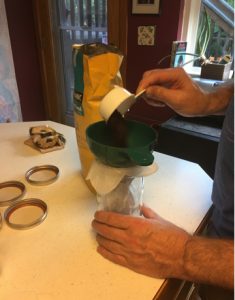
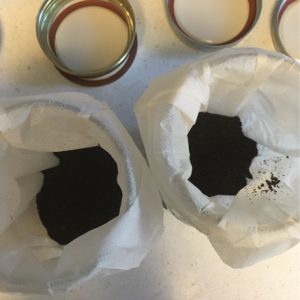
Now, slowly add water to each jar, using a spoon to make sure that all of the grounds are moistened as you add the water. You do not want any of the grounds at the top to be dry!
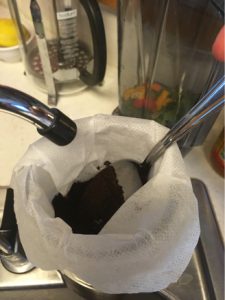
Side view
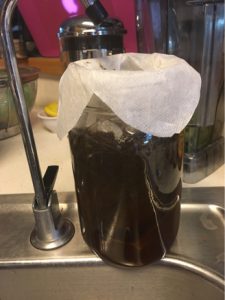
Top view
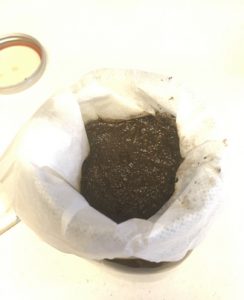
Be sure to fill the jar so that the water comes to nearly the top of the jar!
Now, keeping the top of the filter folded down over the outside of the jar, screw the lid on.
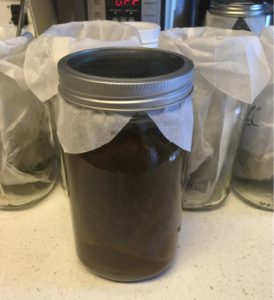
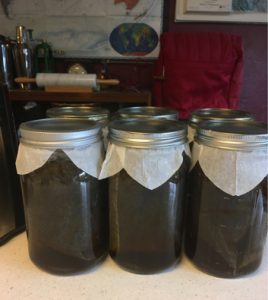
Leave the filled jars on your counter for 12 to 24 hours, depending in part on how strong you like to make your cold brew, and in part on how lazy you are. We make ours in the evening, and leave it on the counter overnight for at least 12 hours. We also make enough for a week at a time.
When they are done (or, if you are like us, when you come out in the morning) they will look like this:
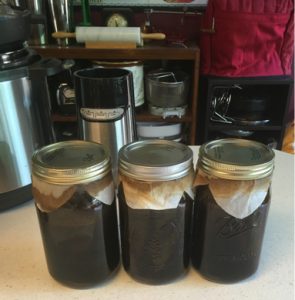
Note that while the filters will be discolored at the top on the outside, they will not leak or drip onto your counter.
Now take the cap off…
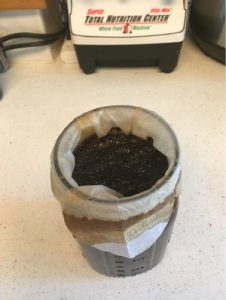
fold up the sides…
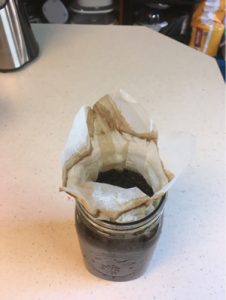
and holding the filter closed, gently start pulling the filter up so that it can drain down into the jar.
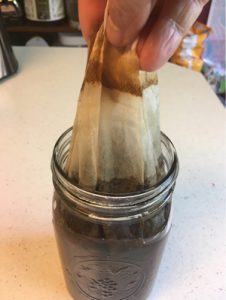
You will probably want to remove the filters over your sink or some other receptacle. Once they are completely drained, you can compost them (yes, the filters (link below) are compostable), or empty them out into your garden, or otherwise dispose of them.
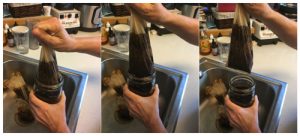
You now have jars full of amazing cold brew coffee concentrate, to which you can add cold water, cold water and ice, or hot water!
Wonderful, smooth dark brew coffee, the lazy person’s way!
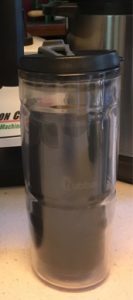
By the way, there are really two perfect ratios for making cold brew coffee. The first is the grounds:water ratio (which will differ depending on method, taste, and grind – for this method we have found the perfect ratio to be 2/3 cup grounds per full jar). Of course the ‘taste’ part means that there really can be no “perfect” ratio, but for this method the 2/3 cup grounds per jar is a darned good start.
The second “perfect ratio” is the cold brew concentrate to water ratio for when you are making your coffee to drink. And if there can really be no perfect ratio for making the cold brew concentrate, there can really be no perfect ratio for how you use it! It’s entirely to taste, depending in large part on how strong you like your coffee. Some people even drink this stuff straight! Most, though, will do either a 1:2 ratio (coffee concentrate to water) or a 1:1 ratio. So start there and adjust to..you got it..taste.
Ok, the filters that we use are the Caffi brand French press coffee filters, and you can get them on Amazon here. You may be able to get them elsewhere, but I’ve only been able to find them on Amazon. Fortunately they are only .21 each, at $21 per 100 pack.
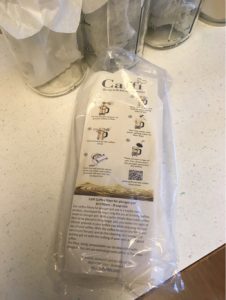
Enjoy!
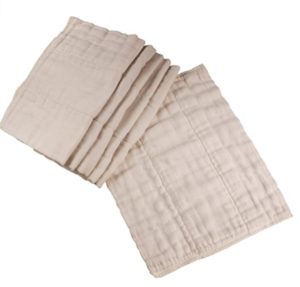

















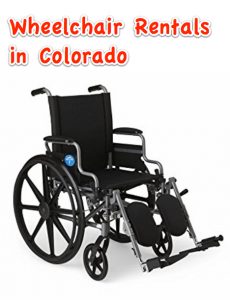

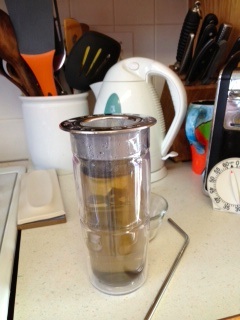

Recent Comments